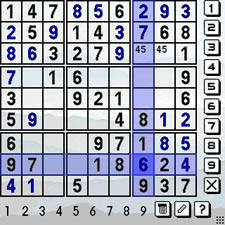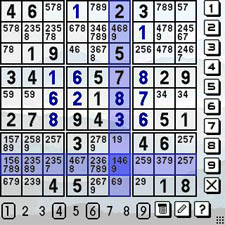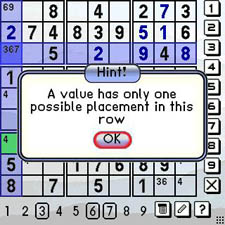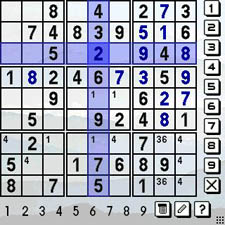 Japan has given us a succession of obsessions these last few decades. Geisha and anim�, for sure, not to mention sumo, samurai, and sushi.
Japan has given us a succession of obsessions these last few decades. Geisha and anim�, for sure, not to mention sumo, samurai, and sushi.
One thing you can't blame on the Japanese, however, is Sudoku, notwithstanding its name. The logic puzzles first appeared in the USA - in New York, wouldn't you know - in the late 1970's. Japan imported them in the mid-80's and hasn't been the same since.
Called "Number Place" this side of the Great Pond, the puzzles picked up the moniker Su-doku in Japan, and the name stuck. In Japanese, su means "number," and doku means "single". At least that's what they'd like us to believe. The noun is both singular and plural, and the dash is optional.
Playability
Looking a little like a crossword puzzle filled with numbers, Sudoku is demonically simple in concept. The digits 1 through 9 are all you need. There's no math involved, just logic. You don't need to know the sums or quotients, only the presence or absence of the requisite digits.
The Sudoku playing field comprises nine horizontal rows and nine vertical columns of boxes, marked off into thirds in both directions. At the start, the puzzles contain some numbers, not necessarily evenly spaced, and often not very many, particularly at higher levels of difficulty. These are clues that enable solving the puzzle. No matter how few of them there are, it's possible by logical means to figure out all the others. Possible, yes. Easy? Not necessarily.
The challenge - i.e., the object of the game - is to fill in all of the empty squares with the numbers 1 through 9 such that every row, every column, and every 3x3 subdivision contains all of the numbers. You can't change any of the givens, and no duplicates, no omissions. Simple, eh?
Well, it can be, though it can also be exquisitely difficult to get them in the right place so everything will work. The process involves reasoning of more or less complexity. Simple puzzles are generally solvable by straight-forward logic - "this square can not be 1, 2, 4, 5, 6, 7, 8, or 9, therefore it must contain a 3" or "there's already a 5 in this block, so this one must not be a 5 and since it can only be 5 or 8, it's got to be 8." Easier to think than to describe in words.
Each puzzle has only one possible solution, and there are no unsolvable puzzles, although some entail advanced reasoning and multiple layers of logic. Correctly created Sudoku never require any out and out conjecture to solve, so guessing is cheating.
Sudoku puzzles, like crosswords, are readily available in books and some newspapers. I found three volumes of them, including a For Dummies outrage, at the local big box super store.
Breaking the rules
 Sudoku is far nicer on the Treo than on paper. Most importantly, it flags mistakes, although masochists can turn that feature off. An erroneous entry in a row or column can mean major frustration and furious erasing on a paper puzzle. I leave the "Flag mistakes" option turned on. Then I know when I've guessed wrong.
Sudoku is far nicer on the Treo than on paper. Most importantly, it flags mistakes, although masochists can turn that feature off. An erroneous entry in a row or column can mean major frustration and furious erasing on a paper puzzle. I leave the "Flag mistakes" option turned on. Then I know when I've guessed wrong.
Astraware's Palm OS Sudoku handles all of the basics with panache. It provides hundreds of pre-made puzzles in six levels of difficulty from Beginner to Diabolical. While solving a puzzle, you'll want to jot a cell's possibilities in it as you narrow the choices. This is a process affectionately termed "pencilmarks" in Sudoku circles. Astraware's Treo Sudoku not only supports the marks, but conveniently permits toggling them as the possibilities narrow or change, and it remembers all of them for the entire board, even if you have to close and reopen the program. The marks appear by tapping their little icons on screen, or via the Treo's keyboard.
Tiny as they are, the pencilmarks are easily readable, even without my reading glasses. A menu option (press the Menu key any old time) offers automatic fill-in for pencilmarks, and it's nearly instantaneous. It's an instant no-no, too. After you invoke the option there's little to do but tap numbers to complete the puzzle - not much thinking required to figure out where they go.
 While working on a square, the corresponding row and column light up, a welcome assist that can't be called cheating. When you fill a square with the correct entry, cool sounds reward success, and the rows, columns, and blocks blink when completed. The program also offers (gasp!) help if you get stuck.
While working on a square, the corresponding row and column light up, a welcome assist that can't be called cheating. When you fill a square with the correct entry, cool sounds reward success, and the rows, columns, and blocks blink when completed. The program also offers (gasp!) help if you get stuck.
 Help comes in several flavors - in addition to the vile automatic pencilmarks option. A tap on the question icon highlights a row in green. This is a "focus point" where it's a known fact (known to the program, anyway) that a number can be deduced. Another tap on the question mark and the focus narrows (darker green) to the actual square. Some more tapping tells you why you should concentrate your effort on the square, and still more tapping dishes up the answer.
Help comes in several flavors - in addition to the vile automatic pencilmarks option. A tap on the question icon highlights a row in green. This is a "focus point" where it's a known fact (known to the program, anyway) that a number can be deduced. Another tap on the question mark and the focus narrows (darker green) to the actual square. Some more tapping tells you why you should concentrate your effort on the square, and still more tapping dishes up the answer.
Totally frustrated? Dinnertime and the potatoes getting cold? You can "Abandon" the game without finishing it (pulldown menu), or use the program's "quick solve" option (mean ol' icon) to bail out. Quick-solve chalks you up as a loser and steps through the solution one square at a time. Game over.
Sorry, wrong number >>
Copyright 1999-2016 TreoCentral. All rights reserved :
Terms of Use : Privacy Policy
TREO and TreoCentral are trademarks or registered trademarks of palm, Inc. in the United States and other countries;
the TreoCentral mark and domain name are used under license from palm, Inc.
The views expressed on this website are solely those of the proprietor, or
contributors to the site, and do not necessarily reflect the views of palm, Inc.
Read Merciful by Casey Adolfsson
 Japan has given us a succession of obsessions these last few decades. Geisha and anim�, for sure, not to mention sumo, samurai, and sushi.
Japan has given us a succession of obsessions these last few decades. Geisha and anim�, for sure, not to mention sumo, samurai, and sushi.
 Sudoku is far nicer on the Treo than on paper. Most importantly, it flags mistakes, although masochists can turn that feature off. An erroneous entry in a row or column can mean major frustration and furious erasing on a paper puzzle. I leave the "Flag mistakes" option turned on. Then I know when I've guessed wrong.
Sudoku is far nicer on the Treo than on paper. Most importantly, it flags mistakes, although masochists can turn that feature off. An erroneous entry in a row or column can mean major frustration and furious erasing on a paper puzzle. I leave the "Flag mistakes" option turned on. Then I know when I've guessed wrong.
 While working on a square, the corresponding row and column light up, a welcome assist that can't be called cheating. When you fill a square with the correct entry, cool sounds reward success, and the rows, columns, and blocks blink when completed. The program also offers (gasp!) help if you get stuck.
While working on a square, the corresponding row and column light up, a welcome assist that can't be called cheating. When you fill a square with the correct entry, cool sounds reward success, and the rows, columns, and blocks blink when completed. The program also offers (gasp!) help if you get stuck.
 Help comes in several flavors - in addition to the vile automatic pencilmarks option. A tap on the question icon highlights a row in green. This is a "focus point" where it's a known fact (known to the program, anyway) that a number can be deduced. Another tap on the question mark and the focus narrows (darker green) to the actual square. Some more tapping tells you why you should concentrate your effort on the square, and still more tapping dishes up the answer.
Help comes in several flavors - in addition to the vile automatic pencilmarks option. A tap on the question icon highlights a row in green. This is a "focus point" where it's a known fact (known to the program, anyway) that a number can be deduced. Another tap on the question mark and the focus narrows (darker green) to the actual square. Some more tapping tells you why you should concentrate your effort on the square, and still more tapping dishes up the answer.